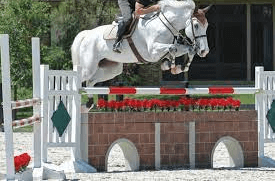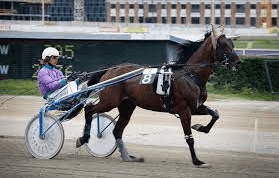What Equipment Is Needed For Show Jumping?

Show jumping, a thrilling and elegant equestrian discipline, requires both the rider and horse to be equipped with specific gear to ensure their safety and optimal performance.
This article aims to provide an overview of the essential equipment needed for show jumping, focusing on the importance of a well-fitted saddle and bridle, a secure helmet for the rider, and protective boots for the horse’s legs along with a properly adjusted martingale. By understanding the significance of these items, riders can enhance their riding experience while maintaining the welfare of their horses.
A well-fitted saddle and bridle are fundamental components of show jumping equipment. The saddle must fit snugly on the horse’s back to provide support and stability during jumps. It should distribute weight evenly across the horse’s back without causing discomfort or restricting movement.
Similarly, a properly fitted bridle ensures effective communication between rider and horse through precise rein aids. The bit used in show jumping bridles is typically designed to offer control while allowing enough freedom for clear communication between both parties. Ensuring that both saddle and bridle are correctly fitted is crucial not only for comfort but also for maintaining balance throughout jumps, ultimately optimizing performance in this exhilarating sport.
Well-fitted Saddle and Bridle
The proper execution of show jumping necessitates the use of a well-fitted saddle and bridle.
To ensure the comfort and safety of both horse and rider, it is essential to have a properly fitted girth that securely holds the saddle in place without causing any discomfort or restriction of movement.
Additionally, selecting a suitable bit for the bridle is crucial in maintaining clear communication between the rider’s hands and the horse’s mouth. The bit should be appropriately sized and designed to suit the individual horse’s needs, taking into consideration factors such as its level of training, sensitivity, and mouth conformation.
Read also: How Can One Prepare A Horse For Show Jumping?
A well-fitted saddle and bridle not only contribute to the overall performance but also prioritize the welfare and freedom of movement for both horse and rider during show jumping competitions.
Secure Helmet for the Rider
The importance of safety and head protection cannot be overstated in the sport of show jumping.
As one of the most high-risk equestrian disciplines, it is crucial for riders to prioritize their own well-being by wearing a secure helmet.
Choosing the right helmet size and fit is essential to ensure maximum protection, as a poorly fitted helmet may not provide adequate coverage in case of a fall or impact.
Importance of safety and head protection
Safety and head protection play a crucial role in show jumping, ensuring the well-being of riders as they navigate challenging courses.
The importance of wearing safety gear while show jumping cannot be overstated, as it not only protects the rider’s head but also ensures rider and horse safety during show jumping.
Show jumping involves high speeds, intricate jumps, and potential falls, making it essential for riders to wear secure helmets that provide adequate protection.
These helmets are designed to absorb impact and reduce the risk of head injuries in case of a fall or collision. They typically feature a hard outer shell and a cushioned inner lining that absorbs shock.
By wearing helmets, riders can mitigate the risks associated with show jumping and confidently focus on their performance without compromising their safety.
Choosing the right helmet size and fit
Selecting the appropriate helmet size and fit is essential in ensuring optimal protection for riders, with studies showing that wearing a properly fitted helmet can reduce the risk of head injury by up to 50%.
To ensure a proper fit, riders should consider the following factors:
- Importance of proper helmet maintenance: Regularly inspecting and maintaining the helmet is crucial for its effectiveness. Riders should check for any signs of damage or wear and tear, such as cracks or loose padding. Additionally, it is important to clean the helmet according to manufacturer’s instructions to maintain its integrity.
- Finding the right helmet brand and style: Every rider has a unique head shape, so it is important to find a brand and style that fits well. Trying on different helmets from reputable brands allows riders to find one that provides maximum comfort and protection. It is recommended to visit a professional retailer who can assist in finding the right fit and style based on individual preferences.
- Properly adjusting straps and harnesses: Once a suitable helmet has been found, it is important to adjust the straps and harnesses correctly. The chin strap should be snug but not too tight, allowing for easy movement while ensuring stability during riding activities. Adjusting other harnesses or retention systems according to manufacturer’s instructions will further enhance the fit.
- Regularly reassessing fit: As riders grow or change hairstyles, their head size may also change over time. Therefore, it is crucial to regularly reassess the fit of the helmet and make necessary adjustments or replace it if needed.
By considering these factors when selecting a helmet size and fit, riders can ensure they have reliable head protection while engaging in show jumping activities.
Protective Boots for the Horse’s Legs and Properly Adjusted Martingale
Protective boots and a properly adjusted martingale are essential for show jumping, ensuring the horse’s legs are adequately protected and the rider has proper control over the horse’s head carriage.
Horse boots provide crucial protection to the horse’s legs during jumps, reducing the risk of injury from impact or accidental strikes. These boots typically cover the cannon bone and fetlock region, shielding them from potential knocks and scrapes. Additionally, some horse boots also offer support to tendons and ligaments, minimizing strain during landing or sharp turns.
On the other hand, a martingale is a piece of equipment that helps maintain control over the horse’s head carriage by limiting how high they can raise their head. Properly adjusting a martingale involves finding the right length so that it does not restrict normal movement but still provides enough control when needed.
By correctly fitting both protective boots and adjusting the martingale, riders can ensure their horses’ safety while maintaining optimal control in show jumping events.
Frequently Asked Questions
What is the purpose of a properly adjusted martingale in show jumping?
A properly adjusted martingale in show jumping acts as a guiding compass, helping to maintain the horse’s head and neck position. Alongside a correctly fitting saddle and bridle, it ensures optimal comfort and control for both horse and rider.
How can I ensure that the saddle and bridle are well-fitted for my horse?
To ensure proper saddle fit, it is essential to consider the horse’s conformation and back shape. The saddle should distribute weight evenly and allow for freedom of movement. Similarly, bridle fit should accommodate the horse’s head shape without causing discomfort or restriction.
Are there any specific guidelines or regulations regarding the use of protective boots for the horse’s legs in show jumping?
Protective boots are commonly used in various equestrian disciplines, including show jumping. Their usage helps prevent injuries and provides support to the horse’s legs during high-impact activities. Neglecting to use protective boots in show jumping can increase the risk of leg injuries for the horse.
What are the key factors to consider when choosing a secure helmet for the rider in show jumping?
Ensuring rider safety in show jumping requires careful consideration of secure helmet features and adherence to helmet safety certifications. The right helmet not only protects the head but also gives riders a sense of liberation as they soar over obstacles.
Are there any other types of equipment or gear that are commonly used in show jumping apart from the ones mentioned in the article?
Different types of show jumping fences, such as verticals, oxers, and combinations, are commonly used in the sport. In addition to secure helmets, the importance of rider attire, including boots and protective vests, should not be overlooked in ensuring safety and performance.
Conclusion
In conclusion, when it comes to show jumping, having the right equipment is crucial for both the rider and the horse.
A well-fitted saddle and bridle ensure proper communication between the rider and the horse, allowing for precise movements and control.
Additionally, a secure helmet is essential to protect the rider’s head in case of a fall or collision.
Furthermore, protective boots for the horse’s legs are necessary to prevent injuries from jumps or accidental knocks. These boots provide support and cushioning, reducing the risk of strains or sprains during high-intensity activities.
Lastly, a properly adjusted martingale can aid in maintaining control over the horse’s head carriage by limiting upward movement.
By investing in quality equipment that fits correctly and provides adequate protection, show jumpers can enhance their performance while ensuring the safety and well-being of both themselves and their horses.
Remember, success in show jumping requires not only skill but also attention to detail when it comes to choosing and using appropriate gear. So make sure to equip yourself with these essentials before you take on those challenging jumps!




